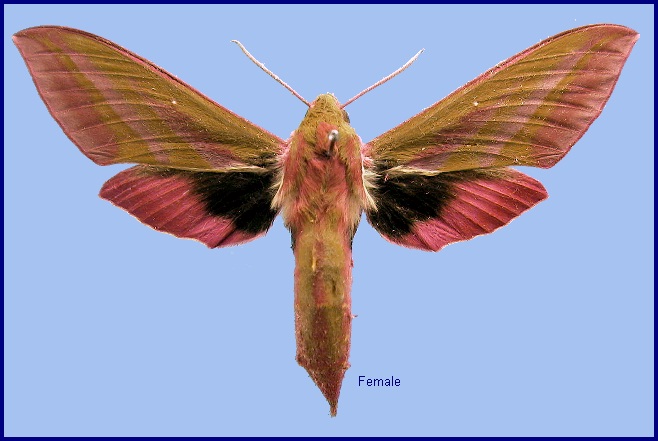
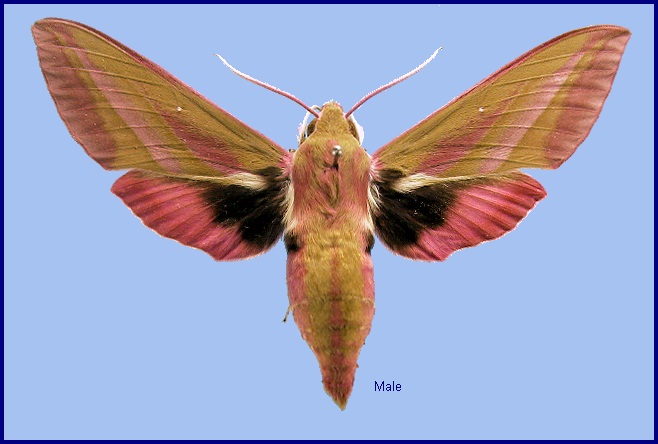
Choerocampa macromera Butler, 1875, Proc. zool. Soc. Lond. 1875: 7. Type locality: [Bangladesh,] Silhet [Sylhet]; N. India.
Synonym. Choerocampa macromera Butler, 1875.
Note. Danner et al. (1998) assigned Yunnanese specimens of Deilephila elpenor to the nominotypical subspecies. However, Mell (1922b) noted that his specimens from Yunnan were transitional between this subspecies and Deilephila elpenor macromera (Butler). Further study may show that there is simply a clinal change in colour in this species through Yunnan and that Deilephila elpenor macromera is not distinct.
Wingspan: 60--84mm. Forewing bronze-green/khaki; costa crimson; an oblique pink band from beyond cell to inner margin, and another parallel with it from apex to inner margin; a broad marginal band bright rosy-red; a white discoidal spot. Hindwing basal half black, distal half rosy-red shading to crimson near apex. Underside bright rosy-red, except the costa and part of the disc of the wings. Head and thorax bronze-green/khaki; antenna, sides of palpus and head pink; broad crimson subdorsal and lateral stripes on thorax; abdomen crimson with a broad bronze-green/khaki subdorsal stripe, and a pink and a black lateral side patch. Very similar to Deilephila elpenor elpenor but black patch on the hindwing upperside more restricted distally. Distal edge of black area of hindwing upperside convex, so that pink area becomes increasingly broader from Cu2 to the costa (and consequently the black area is an almost circular patch).
According to Bell & Scott (1937), in India the moths were frequently caught when feeding at flowers after dusk, and were among the most common Sphingids entering lighted bungalows at night. They were also among the most beautiful in colour and form.
China: 4.vii (Xizang/Tibet).
OVUM: Eggs are laid from May to September in India, several often being found on one plant (Bell & Scott, 1937).
LARVA: Full-fed 100mm; width 13mm. According to Bell & Scott (1937), in the first instar green with a short straight, black horn. In the second instar, head and segment 2 green, rest of body bluish-green dotted with white. Segment 5 swollen and bearing an eye-spot which is pale yellow above, black below; a similar but smaller eye-spot occurs on 6. There is a pale dorso-lateral stripe from segment 2 to base of horn. Horn short, straight, black with reddish base. The third instar is as the second instar, but with the eye-spot shaped like a "D", with the chord of the "D" ventrad, pupil red edged with yellow above, black below. In the fourth instar the basic colour may be brown or green form, the brown form the more common.
In the brown form the head is black, body dark brown with reticulate black lines on segments 6 to 11. There is a black dorsal stripe on 2 and 3, and a pale dorso-lateral and a similar subspiracular stripe also on 2 and 3, the latter extending on to 4 and 5 and very faintly on to 12. Segment 5 is very swollen, the eye-spot large, black with a brown kidney-shaped mark, edged narrowly with white in the middle. A similar but smaller eye-spot occurs on 6. Legs pale brown, prolegs, claspers and venter black; horn long, down-curved, black (Bell & Scott, 1937).
In the green form the black head and brown body-colour is replaced by bluish-green, with markings similar to the above.
In the final instar, the head very small and round. Body dull and smooth; segment 2 of about the same diameter as the head, the segments then increasing rapidly in diameter to 5, which is very swollen. Segments 6 to 12 of less diameter than segment 5. Horn rather short, sharply down-curved, stout at base, tapering evenly to a sharp point.
In colour, head and dorsum of segments 2 to 6 sooty-brown, rest of body darker brown with black reticulation. There is a ochreous dorso-lateral stripe on 2 to 4, bordered broadly with dark brown. There is also an ochreous subspiracular stripe, narrow on 2 and 3, broader on 4 and very broad on 5, narrowing to a point just below the eye-spot on 6, and continued as a faint waved stripe to 12. A large, round, dorso-lateral eye-spot occurs on 5, the upper half containing a kidney-shaped mark; this is greyish-purple edged narrowly with white. A similar but smaller eye-spot occurs on 6, and there is a small round ochreous subdorsal spot on 7 to 12. There are traces of oblique lateral stripes on 5 to 12. Basal half of horn brown, distal half white. Spiracles ochreous ringed with black (Bell & Scott, 1937).
The larva feeds voraciously. In the last instar, when the colour is dark brown, the larva lies during the day on the stem of the hostplant close to the ground, and feeds at night. The anterior segments can be much elongated, but when alarmed the head and anterior segments are retracted into the swollen fifth segment, which becomes still more swollen, showing up the eye-spot to full advantage (Bell & Scott, 1937).
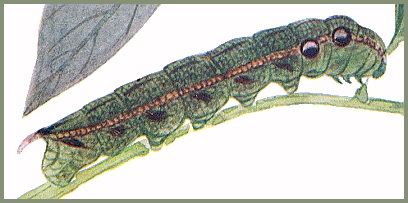
PUPA: 47mm; breadth 12mm; cremaster 3.5mm. Colour of head, thorax and wing-case soiled white, marbled with dark brown on dorsum; abdomen pale orange speckled with black, the hind bevels of segments 8 to 11 darker; spiracles and cremaster black. Latter triangular, ending in a thin shaft with a simple point (Bell & Scott, 1937).
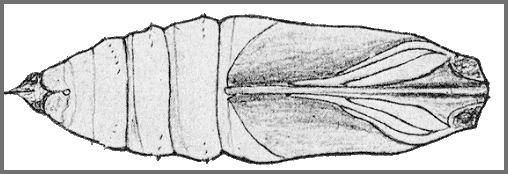
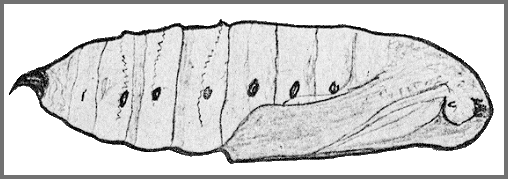
Larval hostplants. Recorded in Yunnan, China, on Epilobium montanum, Impatiens and Osbeckia (Mell, 1922b). Also on Arisaema and Amorphophallus in India (Bell & Scott, 1937).
Unknown.
China: Yunnan (Kunming; Yuxi; Simao/Pu'er; Nujiang Lisu; Lijiang; Bomiluo; Luo Shengeka); Xizang/Tibet (Mainling, Namjagbarwa area, 3050m; Rinbung, 3850m; Yi'ong, 2700m; Yadong, 2900m; Gyaca, 3200m; Lung Xian, 3100m; Qamdo, 3200m; Lhasa) (Wang, 1988).
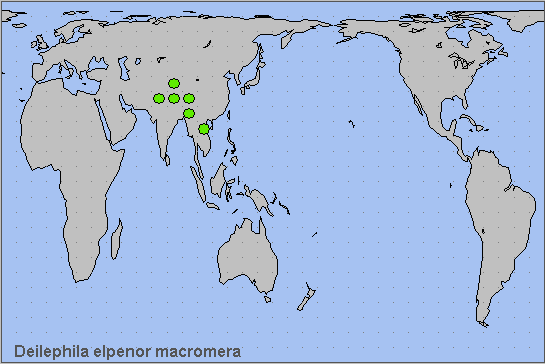
Holarctic; eastern Palaearctic region. Pleistocene refuge: Monocentric -- Yunnan refugium.
 Return to Sphingidae of the Eastern Palaearctic species list
Return to Sphingidae of the Eastern Palaearctic species list